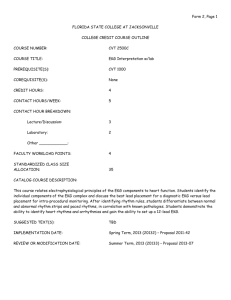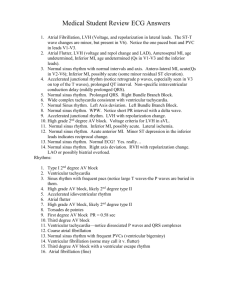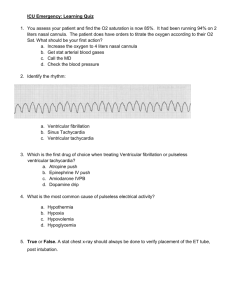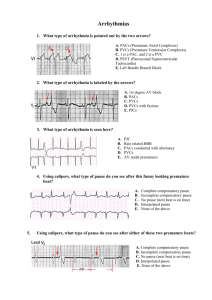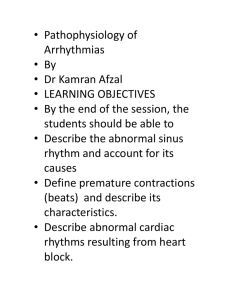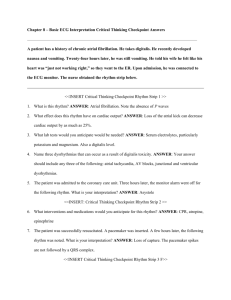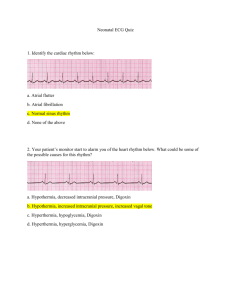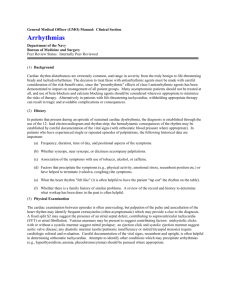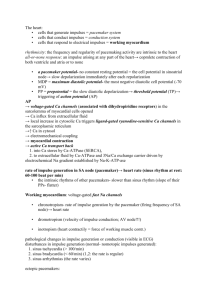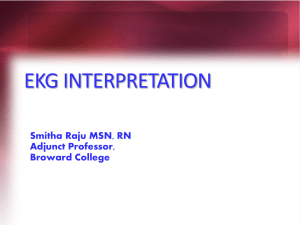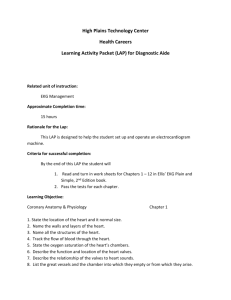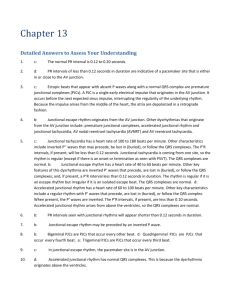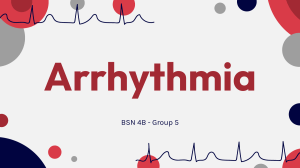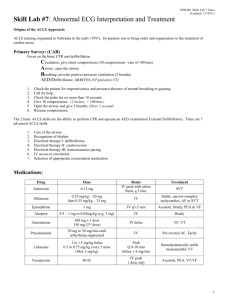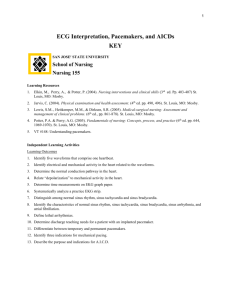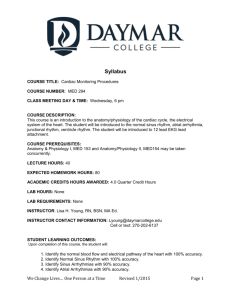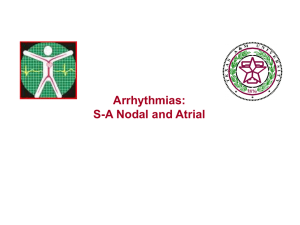EMP 199
advertisement
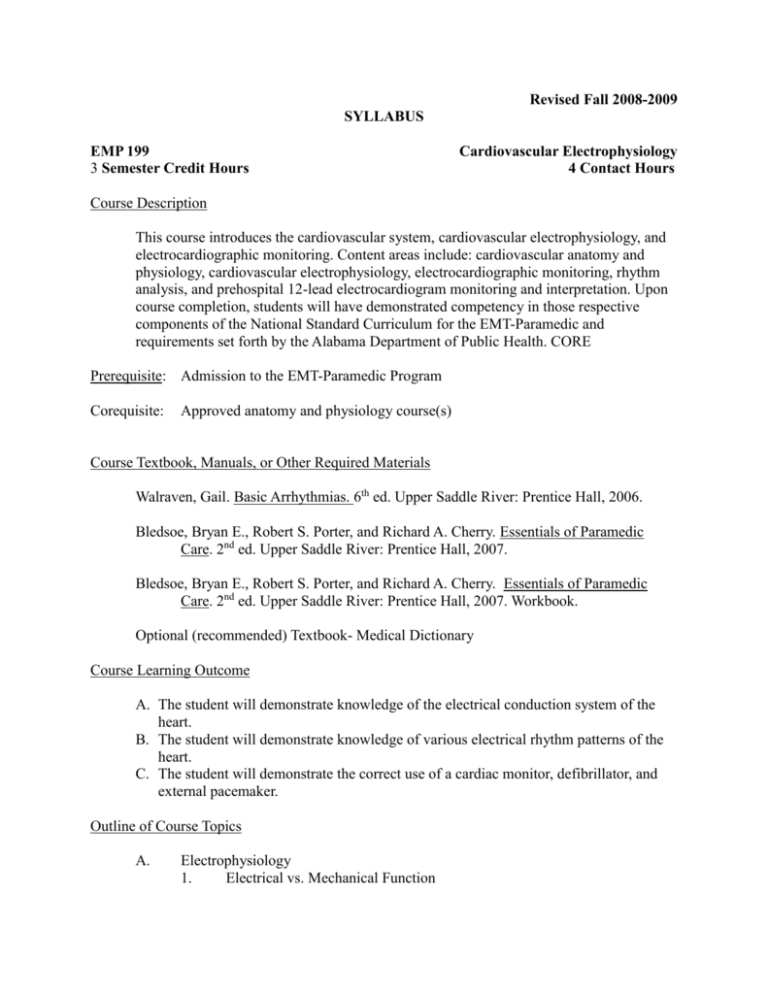
Revised Fall 2008-2009 SYLLABUS EMP 199 3 Semester Credit Hours Cardiovascular Electrophysiology 4 Contact Hours Course Description This course introduces the cardiovascular system, cardiovascular electrophysiology, and electrocardiographic monitoring. Content areas include: cardiovascular anatomy and physiology, cardiovascular electrophysiology, electrocardiographic monitoring, rhythm analysis, and prehospital 12-lead electrocardiogram monitoring and interpretation. Upon course completion, students will have demonstrated competency in those respective components of the National Standard Curriculum for the EMT-Paramedic and requirements set forth by the Alabama Department of Public Health. CORE Prerequisite: Admission to the EMT-Paramedic Program Corequisite: Approved anatomy and physiology course(s) Course Textbook, Manuals, or Other Required Materials Walraven, Gail. Basic Arrhythmias. 6th ed. Upper Saddle River: Prentice Hall, 2006. Bledsoe, Bryan E., Robert S. Porter, and Richard A. Cherry. Essentials of Paramedic Care. 2nd ed. Upper Saddle River: Prentice Hall, 2007. Bledsoe, Bryan E., Robert S. Porter, and Richard A. Cherry. Essentials of Paramedic Care. 2nd ed. Upper Saddle River: Prentice Hall, 2007. Workbook. Optional (recommended) Textbook- Medical Dictionary Course Learning Outcome A. The student will demonstrate knowledge of the electrical conduction system of the heart. B. The student will demonstrate knowledge of various electrical rhythm patterns of the heart. C. The student will demonstrate the correct use of a cardiac monitor, defibrillator, and external pacemaker. Outline of Course Topics A. Electrophysiology 1. Electrical vs. Mechanical Function 2. 3. 4. 5. 6. 7. Sodium Pump Polarization, Depolarization Conduction System Inherent Rates Irritability, Escape Nervous System Influence B. Waves and Measurements 1. Introduction 2. Electrodes 3. Rule of Electrical Flow 4. Monitoring Leads 5. Graph Paper 6. Voltage Measurements 7. Time Measurements 8. Cardiac Cycle 9. Waves, Intervals, Segments 10. P Wave and PRI 11. QRS Complex 12. ST Segment and T Wave 13. Measurements 14. Practice 15. Artifact, Interference 16. Refractory Periods C. Analyzing EKG Rhythm Strips 1. Analysis Format 2. Regularity 3. Rate 4. P Wave 5. PR Intervals and QRS Complexes 6. Role of the AV Node 7. Ventricular vs. Supraventricular D. Sinus Rhythms 1. Introduction 2. Normal Sinus Rhythm 3. Sinus Bradycardia 4. Sinus Tachycardia 5. Sinus Arrhythmia 6. Review E. Atrial Rhythms 1. Atrial Rhythms 2. Wandering Pacemaker 3. Ectopics 4. 5. 6. 7. Premature Atrial Contraction Atrial Tachycardia Atrial Flutter Atrial Fibrillation F. Junctional Rhythms 1. Junctional Pacemaker 2. Junctional P Wave 3. Premature Junctional Contraction 4. Junctional Escape Rhythm 5. Junctional Tachycardia 6. Accelerated Junctional Rhythm 7. Supraventricular Tachycardia G. Heart Blocks 1. Conduction Through the AV Node 2. Heart Blocks 3. First Degree Heart Block 4. Second Degree Heart Blocks 5. Type II Second Degree Heart Block 6. Wenckebach (Type I Second Degree Heart Block) 7. Third Degree Heart Block (Complete Heart Block) F Ventricular Rhythms 1. Ventricular Rhythms 2. Premature Ventricular Contraction (PVC) 3. Unifocal vs. Multifocal 4. R on T Phenomenon 5. Runs and Couplets 6. Grouped Beating 7. Ventricular Tachycardia (VT) 8. Ventricular Fibrillation 9. Idioventricular Rhythm 10. Asystole G. 12-lead ECG Monitoring and Interpretation Methods of Instruction A. B. C. D. E. Lectures Demonstration Supervised Practice Role Play Audio/Visual Presentations Evaluation and Assessment A. B. C. Course Grade Assessment Students who successfully complete this course must accumulate a minimum of 750 of 1000 possible points during the semester. Additionally, the student must pass the following on a Pass/Fail basis: Practical skills and behavioral competencies Departmental Assessment of Learning Outcomes 1. The student will demonstrate knowledge of the electrical conduction system of the heart by scoring a minimum of 75% on a selected written exam. 2. The student will demonstrate knowledge of various electrical rhythm patterns of the heart by scoring a minimum of 75% on a selected written exam. 3. In a designated lab exercise, the student will demonstrate correct use of a cardiac monitor, defibrillator, and external pacemaker according to a skills checklist. Use of Assessment Findings During the Fall In-service of the year following a scheduled review of this course, a committee will review all course assessment materials submitted by the instructors and division chair. The committee will send a report of any recommended curriculum changes to the division chair, who will then submit them to the Student Learning Outcomes Committee. Upon approval by the Student Learning Outcomes Committee, a copy will be filed with the Office of Institutional Planning and Assessment Attendance Students are expected to attend all classes for which they are registered. Students who are unable to attend class regularly, regardless of the reason or circumstance, should withdraw from that class before poor attendance interferes with the student’s ability to achieve the objectives required in the course. Withdrawal from class can affect eligibility for federal financial aid. Statement on Discrimination/Harassment The College and the Alabama State Board of Education are committed to providing both employment and educational environments free of harassment or discrimination related to an individual’s race, color, gender, religion, national origin, age, or disability. Such harassment is a violation of State Board of Education policy. Any practice or behavior that constitutes harassment or discrimination will not be tolerated. Statement of Adherence to ADA Guidelines Instructors will adhere to the Americans With Disabilities Act and/or Section 504 of the Rehabilitation Act (1973) and will publish the following statement on course outlines given to students at the beginning if each semester: “Any individual who qualifies for reasonable accommodations under the Americans With Disabilities Act or Section 504 of the Rehabilitation Act (1973) should notify the instructor immediately.”


